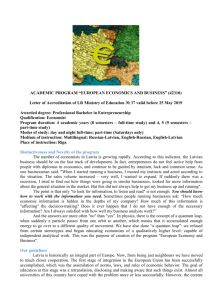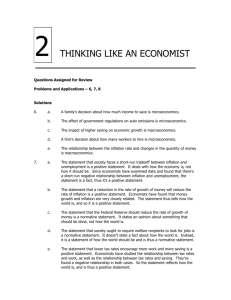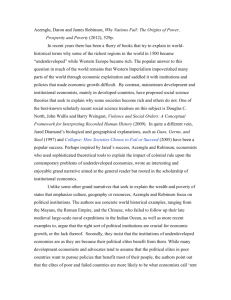Premises for Planning - Economic and Political Weekly
advertisement
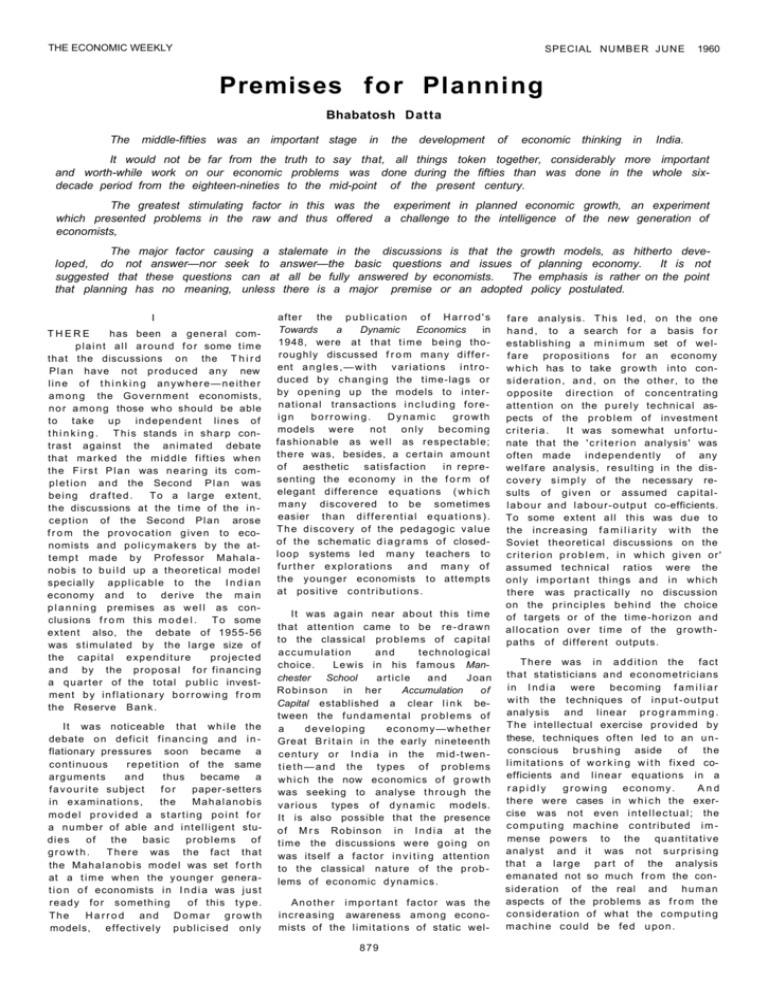
THE ECONOMIC WEEKLY SPECIAL NUMBER JUNE 1960 Premises for Planning Bhabatosh Datta The middle-fifties was an important stage in the development of economic thinking in India. It would not be far from the truth to say that, all things token together, considerably more important and worth-while work on our economic problems was done during the fifties than was done in the whole sixdecade period from the eighteen-nineties to the mid-point of the present century. The greatest stimulating factor in this was the experiment in planned economic growth, an experiment which presented problems in the raw and thus offered a challenge to the intelligence of the new generation of economists, The major factor causing a stalemate in the discussions is that the growth models, as hitherto developed, do not answer—nor seek to answer—the basic questions and issues of planning economy. It is not suggested that these questions can at all be fully answered by economists. The emphasis is rather on the point that planning has no meaning, unless there is a major premise or an adopted policy postulated. I THERE has been a general comp l a i n t a l l a r o u n d f o r some t i m e that the discussions on the T h i r d P l a n have not p r o d u c e d any new line of thinking anywhere—neither a m o n g the Government economists, n o r a m o n g those w h o should be able to take up independent lines of t h i n k i n g . T h i s stands i n s h a r p contrast against the a n i m a t e d debate that m a r k e d the m i d d l e fifties when the F i r s t P l a n was n e a r i n g its comp l e t i o n a n d the Second P l a n was being drafted. To a large extent, the discussions at the t i m e of the i n c e p t i o n of the Second P l a n arose f r o m the p r o v o c a t i o n given to economists a n d p o l i c y m a k e r s by the att e m p t made by Professor M a h a l a nobis to b u i l d up a theoretical model specially a p p l i c a b l e t o the I n d i a n economy and t o d e r i v e the m a i n p l a n n i n g premises as w e l l as conclusions f r o m this m o d e l . T o some extent also, the debate of 1955-56 was s t i m u l a t e d by the l a r g e size of the c a p i t a l e x p e n d i t u r e projected a n d by the p r o p o s a l f o r financing a q u a r t e r of the total p u b l i c investment b y i n f l a t i o n a r y b o r r o w i n g f r o m the Reserve B a n k . It was noticeable that w h i l e the debate on deficit f i n a n c i n g and i n flationary pressures soon became a continuous r e p e t i t i o n of the same arguments and thus became a f a v o u r i t e subject for paper-setters in examinations, the Mahalanobis model provided a starting point for a n u m b e r of able a n d i n t e l l i g e n t studies of the basic problems of growth. T h e r e was the fact that the M a h a l a n o b i s m o d e l was set f o r t h at a t i m e w h e n the y o u n g e r generat i o n o f economists i n I n d i a was j u s t ready for something o f this t y p e . The H a r r o d and Domar growth models, effectively p u b l i c i s e d only after the p u b l i c a t i o n o f H a r r o d ' s Towards a Dynamic Economics in 1948, were at that t i m e b e i n g thoroughly discussed f r o m m a n y d i f f e r ent a n g l e s , — w i t h v a r i a t i o n s i n t r o duced by c h a n g i n g the time-lags or by o p e n i n g up the models to intern a t i o n a l transactions i n c l u d i n g f o r e ign borrowing. Dynamic growth models were not only becoming fashionable as w e l l as r e s p e c t a b l e ; there was, besides, a c e r t a i n a m o u n t of aesthetic satisfaction in representing the economy in the f o r m of elegant difference equations ( w h i c h m a n y discovered to be sometimes easier t h a n d i f f e r e n t i a l e q u a t i o n s ) . T h e discovery of the pedagogic v a l u e of the schematic d i a g r a m s of closedloop systems led m a n y teachers to further explorations and many of the y o u n g e r economists to attempts at positive c o n t r i b u t i o n s . It was a g a i n near about this t i m e that attention came to be r e - d r a w n to the classical p r o b l e m s of c a p i t a l accumulation and technological choice. L e w i s in his f a m o u s Manchester School article and Joan Robinson in her Accumulation of Capital established a clear l i n k between the f u n d a m e n t a l p r o b l e m s of a developing economy—whether Great B r i t a i n i n the early nineteenth c e n t u r y o r I n d i a i n the m i d - t w e n t i e t h — a n d the types of p r o b l e m s w h i c h the now economics of g r o w t h was seeking to analyse t h r o u g h the v a r i o u s types of d y n a m i c models. It is also possible that the presence o f M r s R o b i n s o n i n I n d i a a t the t i m e the discussions were g o i n g on was itself a f a c t o r i n v i t i n g attention to the classical n a t u r e of the p r o b lems of economic d y n a m i c s . A n o t h e r i m p o r t a n t f a c t o r was the increasing awareness a m o n g economists of the l i m i t a t i o n s of static wel879 f a r e analysis. T h i s led, on the one h a n d , to a search f o r a basis f o r establishing a m i n i m u m set of welf a r e p r o p o s i t i o n s f o r an economy w h i c h has to take g r o w t h into cons i d e r a t i o n , a n d , on the other, to the opposite d i r e c t i o n of concentrating attention on the p u r e l y technical aspects of the p r o b l e m of investment criteria. I t was somewhat u n f o r t u nate that the ' c r i t e r i o n analysis' was often made i n d e p e n d e n t l y of any w e l f a r e analysis, r e s u l t i n g in the discovery s i m p l y of the necessary results of g i v e n or assumed capitall a b o u r and l a b o u r - o u t p u t co-efficients. To some extent a l l this was due to the increasing f a m i l i a r i t y w i t h the Soviet theoretical discussions on the c r i t e r i o n p r o b l e m , in w h i c h g i v e n or' assumed technical ratios were the o n l y i m p o r t a n t things and i n w h i c h there was p r a c t i c a l l y no discussion on the p r i n c i p l e s b e h i n d the choice of targets or of the time-horizon and a l l o c a t i o n over t i m e of the g r o w t h paths of different outputs. T h e r e was in a d d i t i o n the fact that statisticians and econometricians i n I n d i a were becoming f a m i l i a r w i t h the techniques of i n p u t - o u t p u t analysis and linear p r o g r a m m i n g . T h e intellectual exercise p r o v i d e d by these, techniques o f t e n led to an u n conscious b r u s h i n g aside of the l i m i t a t i o n s of w o r k i n g w i t h fixed coefficients and linear equations in a rapidly growing economy. And there were cases in w h i c h the exercise was not even i n t e l l e c t u a l ; the computing machine contributed immense powers to the q u a n t i t a t i v e analyst a n d it was not s u r p r i s i n g that a l a r g e p a r t of the analysis emanated not so much f r o m the consideration of the real and h u m a n aspects of the problems as f r o m the consideration of what the c o m p u t i n g m a c h i n e c o u l d be fed u p o n . THE SPECIAL NUMBER JUNE 1960 T h e i m p o r t a n t fact, however, was that the middle-fifties was art i m p o r t a n t stage in the development of economic t h i n k i n g i n I n d i a . One has o n l y to compare the types of discussions that were common in the field of I n d i a n economic problems before the Second W o r l d W a r , or even d u r i n g it and the m u c h more nature type that came to appear in the fifties. It would not be far f r o m the t r u t h to say that, a l l things taken together, considerably more i m p o r t ant and worth-while w o r k on o u r economic problems was done d u r i n g the fifties than was done in the whole six-decade p e r i o d f r o m the eighteennineties to the m i d p o i n t of the present century. It is necessary to remember that the greatest s t i m u l a t i n g factor in this was the experiment in planned economic g r o w t h , an experiment w h i c h presented problems i n the raw and thus offered a challenge to the intelligence of the new gener a t i o n of economists. II T h e m o m e n t u m gathered in the fifties is still w o r k i n g in a number of fields, but it is clearly noticeable that there has not been in the recent months a n y t h i n g l i k e the breakt h r o u g h one saw at the t i m e the Second P l a n was being prepared. One easy explanation w o u l d be that the field has been more or less f u l l y worked out and that we k n o w broadly where we are. T h e o n l y remaini n g gaps, according to this explanation, are quantitative data — p r o d u c t i o n data, i n p u t - o u t p u t data, data about the rates of change a n d so on and so f o r t h ; if these are. available in increasing variety and quantity, we can b u i l d up the framework of any p l a n . A second explanation would be that excursions into the g r o w t h models have indicated their p u r e l y mechanical nature and consequently their l i m i t a t i o n s as w o r k i n g tools. The mathematics —- relatively easy, but l o o k i n g f o r m i d a b l e to those to w h o m a single rotational or operator symbol, or even an italicised letter, is a t e r r o r — c a n be put only in a very general f o r m , the p a r t i c u l a r types of functional relations being either unknown or based on given co-efficients. A l l that can sometimes be forced is that there are consistent and meaningful solutions. The stage is thus left open to the econometricians, who can give a body to the equations. It is however realised that the forms given to the equations on the basis of observed or assumed data do not really represent w h a t is wanted i n a p l a n n i n g economy w i t h a long-term perspective. T h e r e is the difficulty that the independently derived co-efficients m a y not all be realistic together in the same system, when some of the i m p o r t a n t values are changing. A n d , there is also the difficulty a r i s i n g f r o m the fact that it w o u l d be the deliberate purpose of p l a n n i n g to change some of the coefficients. The major factor causing a stalemate in the discussions is that the g r o w t h models, as h i t h e r t o developed, do not answer—nor seek to answer —the basic questions a n d issues of a p l a n n i n g economy. It is not suggested that these questions can at a l l be f u l l y answered by economists. The emphasis is rather on the p o i n t that p l a n n i n g has no meaning, u n less there is a m a j o r premise or an adopted p o l i c y postulated. T h i s postulate carries w i t h i n i t a l l the value-judgements of the c o m m u n i t y and thus gives the necessary shape to the forms of equations a n d defines the set of targets. It is easy to speak about a ' m a x i m a n d ' , b u t it is also easy to forget the elementa r y index number p r o b l e m i n v o l v e d i n the d e f i n i t i o n o f the m a x i m a n d f o r the economy as a whole. There is a stage at w h i c h g r o w t h economics shades into welfare economics a n d one has to leave the mechanical w o r l d of technical inter-relations a n d move into the h u m a n w o r l d of what is most desirable among the feasible alternatives, or what is most feasible among the desirable alternatives. It is easy these days to r e m i n d ourselves that the establishment of a m a j o r premise or a set of premises is not a p u r e l y economic p r o b l e m , and. in any case, not an easy problem. It is not, however, always realised that non-technical issues a n d questions are often i n e x t r i c a b l y m i x ed up w i t h the supposedly technical ones at almost every step. A good example is discussions based u p o n 'surpluses' in the a g r i c u l t u r a l sector p r o v i d i n g resources f o r developing the non-agricultural sector. If a surplus is defined as the difference between the o u t p u t in a p a r t i c u l a r line o f a g r i c u l t u r a l p r o d u c t i o n a n d given wages or given consumption levels i n that line, and i f given capital-labour-output ratios are taken f o r a l i n e of non-agricultural product i o n , the results can be easily calculated. T h e n , by v a r y i n g the different values, w i t h i n the range of freedom permitted by the system, one can find 880 ECONOMIC WEEKLY o u t various combinations o f the t w o outputs possible in the system, subject perhaps to certain m i n i m u m a n d m a x i m u m constraints. From this it is possible to find out how the n o n - a g r i c u l t u r a l o u t p u t can be m a x i mised or at what outputs the two sectors w i l l be at e q u i l i b r i u m . T h e question that remains unanswered is whether it is at a l l desirable to extract the so-called surplus f r o m the a g r i c u l t u r a l sector. T h e s u r p l u s o f the a g r i c u l t u r a l sector can be conceived either on the basis of g i v e n levels of consumption in that sector or on the basis of some idea about the desirable levels of consumption. E i t h e r of these i n volves a m a j o r decision about the d i s t r i b u t i o n of incomes and benefits a r i s i n g f r o m planned g r o w t h . I t i s interesting to note that both in the 'capitalistic' development of Great B r i t a i n in the early nineteenth cent u r y and in the socialistic development of Soviet Russia in the recent decades, the m a i n emphasis was on the desirability of developing the n o n - a g r i c u l t u r a l sector. In Great B r i t a i n , it was the food problem of the new i n d u s t r i a l areas that was the uppermost, and, in Soviet Russia, it was the deliberate p o l i c y of the government to extract as m u c h as possible f r o m the a g r i c u l t u r a l sector. In the b o t h of these, the adopted p o l i c y postulate was weighte d heavily i n f a v o u r o f the indust r i a l classes and against the agricult u r a l classes. A surplus can be generated in agriculture by keeping consumption levels steady w i t h an increase in output, or at least by preventing consumption in the a g r i c u l t u r a l sector f r o m r i s i n g at a rate equal to the rate at w h i c h a g r i c u l t u r a l prod u c t i o n is g r o w i n g . In both of these, there is an i m p l i c i t d i s t r i b u t i o n hypothesis. It is, of course, possible to generate a surplus in agriculture by reducing the numbers dependent on it accompanied by a steady or increasing a g r i c u l t u r a l output. As long as the diverted a g r i c u l t u r a l p o p u l a t i o n produces some net output elsewhere, a p o l i c y of this nature w o u l d be less open to objections t h a n those mentioned above, but the probl e m of a distribution-postulate is not entirely eliminated. A n d , even i f the policymakers proceed in a p r a g m a t i c manner f r o m one practicable step to another, it is the d u t y of the economist to b r i n g i n t o the open the t y p e of social welfare m a j o r premise that the adopted p l a n involves. THE ECONOMIC SPECIAL NUMBER JUNE 1960 WEEKLY A closely-allied case in p o i n t is the proposal f o r t a x i n g a g r i c u l t u r e w i t h a view to p r o v i d i n g resources for the T h i r d P l a n . A decision to tax a g r i c u l t u r e is a decision to reduce the current share of the present generation of agriculturists in the national income, w i t h a view to1 increasing the current share of other groups, a n d / o r w i t h a view to i n creasing the future incomes of all or some groups. There is no a priori reason w h y such a decision should not be taken, but it is often forgotten that there is no a priori reason w h y such a derision should be taken. It is possible that there w o u l d be general agreement in regard to the desirability of increasing the taxburdens on the a g r i c u l t u r a l sector but it should be clearly recognised that there is a m a j o r income-distribution hypothesis i m p l i c i t i n w h a t appears on the surface s i m p l y as a policy for raising resources for the p u b l i c sector, or for securing a balance between aggregate demand and s u p p l y . The neglect of the d i s t r i b u t i o n p r o b l e m is patent in such arguments as that the sector p r o d u c i n g nearly 50 per cent of the national income is not c o n t r i b u t i n g its share to the national exchequer. It is also surp r i s i n g that in m a n y cases the argument for t a x i n g agriculture has been based on the presumption that there has been a large increase in i n comes of the agriculturists. Even if the presumption is correct, there is s t i l l no knowledge about how the income increase has been distributed within the agricultural sector. W h a t is more i m p o r t a n t is that there is no necessary welfare basis f o r the contention that the g r o u p that has received the largest absolute or relative increment in income is the group w h i c h should bear an increased share of the total costs of devel o p m e n t It is easy to see that planned development w i l l often mean a large increase in the incomes of the poorest groups, that many w o u l d consider this to be a desirable result of p l a n n i n g , that even after the increase in incomes, the poorest g r o u p m a y still remain in the lowost position in the distribution-scale, a n d that the increase May be very unevenly dist r i b u t e d w i t h i n the g r o u p . I f the a g r i c u l t u r a l sector has to be taxed, the arguments have to be that i n dustrialisation is considered desirable and that is the society's judgement, that development should be financed by preventing a large rise i n the incomes i n the a g r i c u l t u r a l sector. The society can adopt the postulate that the groups that are relatively r i c h should bear a larger share of the tax-burden, It can also adopt the postulate that the groups that have become richer than they were should bear an increased share of the development costs. It is often forgotten that either of these is a value-judgement and that these two postulates are not identical. III We have now reached a stage at which the fundamentals should be clearly stated and f u l l y considered. The First Plan was one of u t i l i s i n g excess capacities and of making good large and g l a r i n g deficiencies. It is almost certain that a referend u m in 1951 w o u l d have almost unanimously supported the major aims of the First Plan and that we would have been able to get a democratically derived social welfare maj o r premise. The problem of choice originates in the existence of, or potentiality for, variety, and at a stage where the elemental needs have been satisfied. The Second Plan d i d b r i n g in the choice problem, but for a t i m e the technological problem held the field and the more fundamental problems were kept in the backg r o u n d . It is time now that the economists went b o l d l y into the problems of inter-personal d i s t r i b u t i o n . time-horizons and inter-temporal distribution. It should not be possible for the economists to escape f r o m their resp o n s i b i l i t y by h o l d i n g that a decision about inter-personal and inter-temporal d i s t r i b u t i o n is not a purely economic decision. A r g u i n g on that, line, the political scientists, the p o l i ticians, or the technicians could a l l escape the responsibility f o r decision-making. The facts are that decisions have to be made and that it w o u l d be better to make the decisions consistent a m o n g one another and w i t h some major premise than to proceed g r o p i n g l y f r o m one step to another. T h e economists w i t h their t r a i n i n g should be able to contribute somewhat more than those without the t r a i n i n g . I f non-economic variables are i m p o r t a n t , there is the economic p r o b l e m of choosing among these non-economic variables, i.e., of deciding w h i c h of the non-econom i c variables should be given p r i ority. Even i f the economist cannot do a n y t h i n g else, he can serve by constantly emphasizing 881 the need f o r h a v i n g a major premise — i n c o r p o r a t i n g inter-personal and inter-temporal income distribut i o n targets—right in the forefront when policy decisions are adopted. There is a vaguely effective distribution, hypothesis in our plans, originating f r o m the r u l i n g political party's resolution on the establish' ment of a socialistic pattern of society. It has not, however, been clearly recognised that there is an infinite number of ways in w h i c h income-inequalities can be reduced, and again an infinite number of alternative time-rales at w h i c h i n come-equalisation can be brought about. A n d , in actual policy f o r m u lations, it is the question of raising resources that has often been given p r i o r i t y . Commodity targets have been l a i d d o w n on the basis of some sort of an 'essentiality c r i t e r i o n ' , but it has not been realised that the definition of essentiality begs the whole question of the social welfare funct i o n . The inter-temporal analysis undertaken so far has been little more than a statistical projection of certain broad categories over a period of the next 10 or 15 years. It is, of course, possible to go too far in the opposite d i r e c t i o n . There is no reason w h y a major premise, once adopted, should be r i g i d l y adhered to at all costs. There should always be scope for recognising changes in the structural and institutional s e t u p and in attitudes and preference-patterns, and there should further be scope for recognising the errors of judgement previously comm i t t e d . But there must be at any point or period of time a welfare premise in terms of which the details are to be worked out and the progress evaluated and the f a i l u r e to w o r k out its inter-personal and intertemporal d i s t r i b u t i o n implications, may lead to many difficulties, includi n g the setting up of m u t u a l l y inconsistent targets. T h i s danger is real in I n d i a , where it is generally held that agricultural outputs should be increased, that the price of food to the nona g r i c u l t u r a l p o p u l a t i o n should be low, that the agriculturist should get an incentive f o r his w o r k , that he should bear a large share of burdens of development, that his income should be increased, and so on and so f o r t h . The problems arising f r o m these inconsistent targets can be easily solved in a totalitarian economy. But in a country in w h i c h SPECIAL NUMBER JUNE 1960 the weapons of a t o t a l i t a r i a n econ o m y are n o t available, one has to decide o n m a n y questions, a l l i n v o l v i n g decisions on the desired changes a n d rates of changes in incomedistribution. T h e answers to these questions i n v o l v e difficulties. A p a r t f r o m the Index n u m b e r p r o b l e m in the defin i t i o n o f the desirable output-mix, there is the fact that the f u t u r e is not j u s t a block a l t e r n a t i v e to the present. There i s a n i n f i n i t e v a r i e t y of futures—alternative bundles of a l t e r n a t i v e time-paths of different outputs o f d i f f e r e n t lines o f p r o d u c t i o n , w i t h the associated a l t e r n a t i v e time-pattern, of changes in the i n come distribution. And, besides, the time-paths all spread i n t o the infinity. T h e f i r s t essential for bringing everything into manageable p r o p o r t i o n s is to consider the p r o b l e m i n terms o f specified timehorizons. It is possible to take a v e r y long v i e w — t h e h i s t o r i a n ' s v i e w i n the reverse g e a r — r e m e m b e r i n g that fifty years or a c e n t u r y is not h i n g i n the h i s t o r y o f a n a t i o n . It is alternatively possible to proceed on the basis that the results of p l a n n i n g — i n terms o f consumer g o o d s s h o u l d b e e n j o y e d b y the m a j o r i t y o f the present w o r k i n g f o r c e i n their own lifetime. I n that case, the app r o p r i a t e t i m e - h o r i z o n s h o u l d be 15 years or thereabouts. It is of course possible' to take—as is o f t e n d o n e — an election-to-election v i e w , which w i l l put a p r e m i u m on short-gestation projects. Generally, of course, it is a m i x t u r e that w o u l d be f o u n d to be o p e r a t i v e , but here a g a i n one comes face to face w i t h the desirable timem i x of the projects i n c l u d e d in the plan. IV T h e economist can be of real help i n p r o v i d i n g the analytical framew o r k f o r b r i n g i n g together the alternative feasible social w e l f a r e postulates and the technical requirements o f the different types o f plans. I n f a c t , he is q u a l i f i e d only f o r this, and it is not s u r p r i s i n g that he can be no belter t h a n pedestrian when o f f e r i n g advice on specific problems of t a x a t i o n or r a i s i n g resources or selecting projects. T h e fact that the economist cannot offer a u n i q u e or satisfactory answer to the p r o b lems raised by h i m is not the i m portant point. What really is important is that the complex of issues should be sorted out. a n d one should be able to specify exactly where THE ECONOMIC WEEKLY non-economic elements enter into the economic p r o b l e m s , w h a t these non-economic elements a r e a n d w h a t are the i m p l i c a t i o n s o f the different degrees of i m p o r t a n c e attached to p a r t i c u l a r non-economic v a r i a b l e s . W e l f a r e economics hag f o r a l o n g t i m e engaged itself in the rather sterile field of the static allocation problem. It is now r e l a t i v e l y easy to state the c o n d i t i o n s of optimisation a n d one k n o w s where the econ o m i s t qua economist has to stop. T h e r e is, however, the immense field o f economic g r o w t h whose w e l f a r e e c o n o m i c s — i n the f o r m of a theory o f economic p o l i c y — c a n make valuable contributions, even if these sometimes consist in i n d i c a t i n g certain limits and limitations. There are fields in w h i c h the first essential is to pose the questions l o g i c a l l y and accurately. O n e notes that m a n y of these questions have not yet been asked in I n d i a and that a considerable a m o u n t o f h y p o t h e t i c a l m a t t e r has o f t e n been t a k e n f o r g r a n t e d . T h e basic p r o b l e m of i n c o m e dist r i b u t i o n has not yet been studied i n I n d i a either b y statisticians o r b y economists, despite the fact that there has been a f a i r l y l a r g e v o l u m e o f theoretical w o r k o n the p r o b l e m of the i n t e r r e l a t i o n between incomeg r o w t h a n d macro-economic income distribution. L i t t l e is known, here about i n c o m e - d i s t r i b u t i o n by sectors a n d there is p r a c t i c a l l y no i n f o r m a t i o n about intra-sector d i s t r i b u t i o n . T h e discussions in terms of broad sectors n a t u r a l l y raise the question o f inter-sector i n c o m e distribution, and policy conclusions regarding the d i s t r i b u t i o n of p l a n n i n g costs r e q u i r e i n f o r m a t i o n about the i n t r a sector position as w e l l . Now that m a n y of the regional and c i t y surveys have been completed, there should be an encouragement of statistical and economic investigation o f the p r o b l e m o f income-distribution. T h e w o r k i s one l a r g e l y f o r the statisticians, but economists can also help considerably in interpreti n g the data a n d in a n a l y s i n g the probable economic effects of the changes in distribution brought about by planned development, by t a x a t i o n , o r b y the deliberate adopt i o n of p a r t i c u l a r types of d i s t r i b u t i o n policies. T h e r e are other problems also, some of them of w i d e r i m p o r t a n c e . T a k e , f o r e x a m p l e , the question o f the welfare-significance of a w i d e n 882 i n g o f the f i e l d o f choice available to the consumers. T h e question was not o f m u c h i m p o r t a n c e under the F i r s t P l a n , b u t i t i s obvious that w i t h the increase in the v a r i e t y of consumer goods p r o d u c e d i n I n d i a , the question is b e c o m i n g i m p o r t a n t , T h e r e is, s i m i l a r l y , the question of the w e l f a r e significance of expandi n g e m p l o y m e n t per se. T h e r e have been proposals f o r the a d o p t i o n of unorthodox methods f o r creating e m p l o y m e n t — i f necessary, at wages below the m a r k e t rates. If other choices are a v a i l a b l e , there is some c o n t r i b u t i o n that the economists can make i n b r i n g i n g the issues i n t o clearer l i g h t . T h e r e are, besides, a l l the p r o b l e m s r e l a t i n g to the generation of sectoral surpluses a n d those regarding the d i s t r i b u t i o n of the costs of development a m o n g d i f f e r e n t groups of persons and over d i f f e r e n t periods of time. T h e economists w h o have been a n a l y s i n g v a r i o u s types o f growth models can easily go one step f u r ther and i n t r o d u c e income-distribut i o n e x p l i c i t l y i n t h e i r models. One can e n q u i r e , f o r example, what happens to a p a r t i c u l a r multi-sector g r o w t h m o d e l , w h e r e We have not only certain technical and behavioural relations, b u t also certain d i s t r i b u t i o n goals to achieve, and when we k n o w that distributional changes m a y be causes, effects, targets and also instruments of p o l i c y . One easy w a y o u t w o u l d be to suggest that the p r o b l e m of d i s t r i b u t i o n is one that the state can lake up i n dependently of any other considera t i o n . But as l o n g as a d i s t r i b u t i o n p a t t e r n a n d the process of c h a n g i n g it have effects on p r o d u c t i v i t y , such a clear-cut separation is i n a d m i s s i b l e in an analysis of the theory of economic policy. T h e T h i r d Plan w i l l i n m a n y ways be a technical f o l l o w - u p of the sec o n d , and one m i g h t say that w i t h the tracks already l a i d d o w n , there is not m u c h that the economist can say on the technical side. But this need not i n h i b i t in any w a y the analysis of m a n y of the basic problems of economic g r o w t h that have not yet been studied in the I n d i a n context. T h e r e is. therefore, a p r o v o k i n g challenge b e f o r e the economist in I n d i a a n d it should be possible to hope the discussions on the p r o b l e m o f economic development will run a l o n g m a n y new lines in the c o m i n g years. THE ECONOMIC SPECIAL NUMBER JUNE 1960 WEEKLY 888 THE ECONOMIC WEEKLY SPECIAL NUMBER JUNE 1960 884
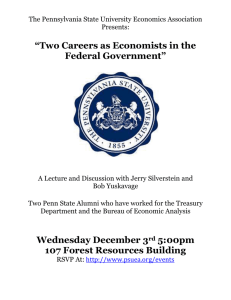
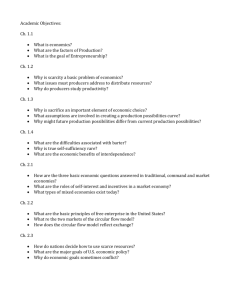

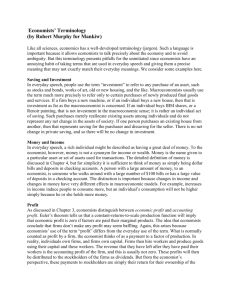
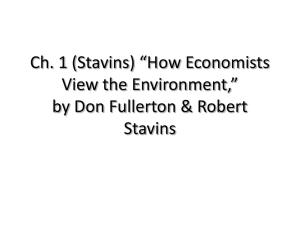
![[B, 30-31]](http://s3.studylib.net/store/data/007815486_2-48862856738849afa7146f2e539fb776-300x300.png)
